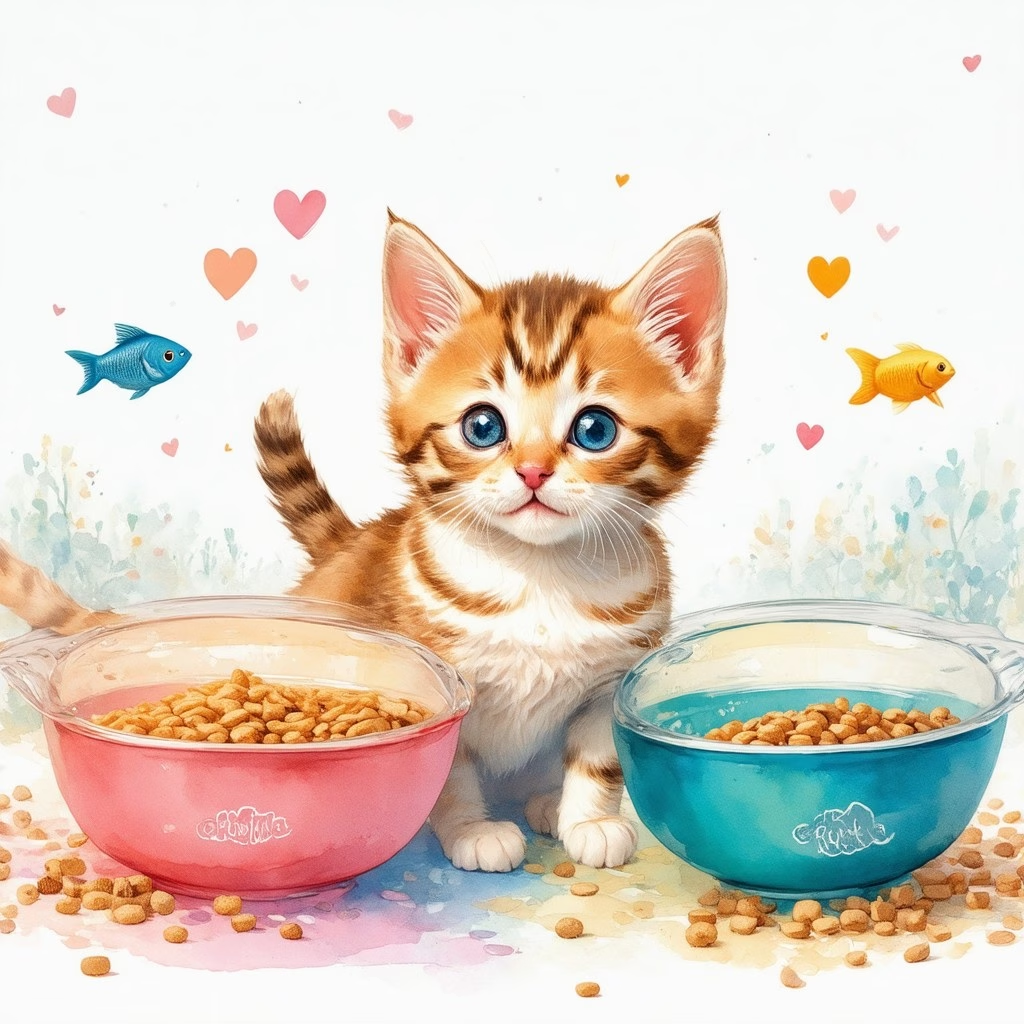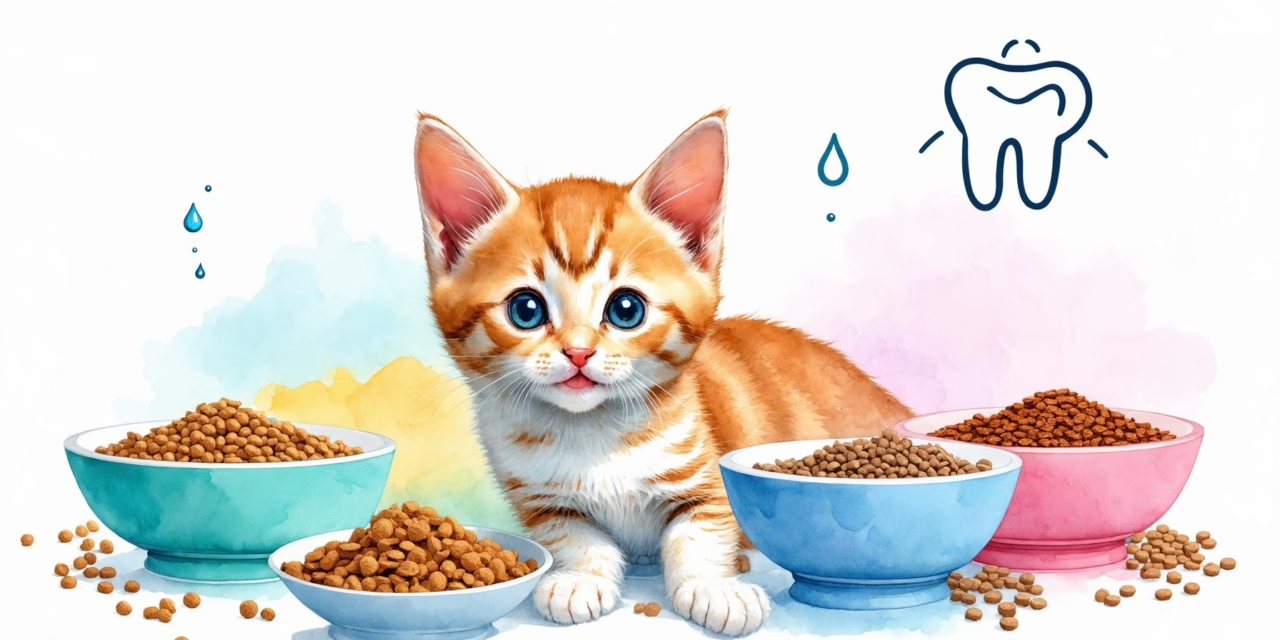Key Takeaways
- Choosing high-quality kitten food is vital for your kitten’s growth, focusing on options that are specifically formulated for their developmental needs.
- Opt for wet kitten food for hydration and palatability, while incorporating dry kitten kibble for dental health and convenience.
- A balanced diet should include essential nutrients like protein, fats, vitamins, and minerals to support overall health.
- Establish a consistent feeding schedule, ideally 4 times a day, to meet their high energy needs during rapid growth.
- Consult a veterinarian for personalized dietary recommendations, especially if your kitten has specific health concerns or dietary sensitivities.
Choosing the right kitten food is crucial for ensuring your furry friend grows up healthy and strong. With so many options available, from Purina One to Fancy Feast, it can be overwhelming to determine what is best for your kitten’s unique needs. In this comprehensive guide, we will explore the essential factors to consider when selecting the best food for kittens, including the differences between wet kitten food and dry kitten food, as well as the ideal feeding schedules that promote optimal growth. We will also address common questions such as, “What type of food is best for kittens?” and “Should kitten dry food be left out all day?” By the end of this article, you will have a clear understanding of how to meet your kitten’s nutritional needs and ensure they thrive during their early stages of life.
What type of food is best for kittens?
When considering the best food for kittens, it is essential to prioritize their nutritional needs for optimal growth and development. Kittens require a diet that is specifically formulated for their life stage, as they have different dietary requirements compared to adult cats. Here are key recommendations:
Best kitten food options for different ages
1. Canned Kitten Food: High-quality canned kitten food is recommended due to its higher moisture content and nutrient density. Look for brands that list meat as the first ingredient and contain essential nutrients such as taurine, DHA, and arachidonic acid. Notable brands include:
- Royal Canin: Known for its tailored nutrition for kittens.
- Hill’s Science Diet: Offers balanced nutrition with a focus on growth.
- Wellness CORE: Grain-free options that provide high protein content.
- Purina Pro Plan: Formulated with real meat and essential vitamins.
2. Dry Kitten Kibble: While canned food should be the primary diet, dry kitten kibble can be offered for snacking and dental health. Ensure that the kibble is specifically designed for kittens, as it will have the necessary nutrients for their development.
3. Nutritional Considerations: When selecting food, ensure it is rich in:
- Protein: Essential for muscle development.
- Fats: Important for energy and healthy skin.
- Vitamins and Minerals: Such as calcium and phosphorus for bone growth.
4. Mixing Foods: It is generally safe to mix different types of kitten food, but it is crucial to introduce new foods gradually to avoid digestive upset. Always monitor your kitten’s response to new foods.
5. Consultation with a Veterinarian: For personalized dietary recommendations, consult with a veterinarian who can provide insights based on your kitten’s specific health needs and lifestyle.
In summary, the best food for kittens includes a combination of high-quality canned kitten food and dry kibble, ensuring a balanced diet rich in essential nutrients. For further reading on feline nutrition, refer to resources from the American Association of Feed Control Officials (AAFCO).
Nutritional needs of kittens and how to meet them
To meet the nutritional needs of kittens, it’s vital to understand their specific dietary requirements. Kittens grow rapidly, and their food must support this growth. Here are the key nutritional needs:
- High Protein Content: Kittens require a diet that is high in protein to support their muscle development. Look for kitten food that contains at least 30% protein.
- Essential Fatty Acids: Fats are crucial for energy and help maintain healthy skin and coat. Ensure the food contains omega-3 and omega-6 fatty acids.
- Vitamins and Minerals: Important for overall health, including calcium and phosphorus for strong bones. A balanced kitten food will have these nutrients in the right proportions.
- Hydration: Since kittens are prone to urinary issues, incorporating wet food into their diet can help maintain hydration levels.
By providing a balanced diet that meets these nutritional needs, you can ensure your kitten grows into a healthy adult cat. For more tips on kitten care, check out our kitten care tips.

Is it Better to Feed Kittens Wet or Dry Food?
When considering whether to feed kittens wet or dry food, it’s essential to evaluate various factors that contribute to their health and development:
- Hydration: Wet food contains approximately 70-80% water, which is crucial for kittens, especially during their rapid growth phase. Adequate hydration supports kidney function and overall health (Source: American Veterinary Medical Association).
- Digestive Health: Kittens often have sensitive stomachs and smaller teeth, making wet food easier to chew and digest. The softer texture can help prevent gastrointestinal issues (Source: Cornell University College of Veterinary Medicine).
- Nutritional Benefits: High-quality wet food is rich in essential nutrients, including proteins and fats necessary for growth and development. It often contains fewer fillers compared to dry food, ensuring that kittens receive a balanced diet (Source: Association of American Feed Control Officials).
- Increased Palatability: Many kittens prefer the taste and aroma of wet food, making it a better option for picky eaters or those transitioning from nursing to solid food (Source: Journal of Animal Science).
- Dental Health: While wet food is beneficial for hydration and digestion, dry food can help reduce plaque and tartar buildup due to its crunchy texture. This can support dental health, but it should not be the sole source of nutrition (Source: Veterinary Oral Health Council).
- Cost-Effectiveness: Dry food is generally more affordable and can be left out for free-feeding, which is convenient for busy pet owners (Source: Pet Food Institute).
- Convenience: Dry food has a longer shelf life and is easier to store, making it a practical choice for many households (Source: Pet Food Manufacturers Association).
- Mental Enrichment: Dry food can be used in puzzle feeders or for training, providing mental stimulation and encouraging natural hunting behaviors (Source: Animal Behavior Society).
- Feeding Strategy: It is advisable to start with wet food as the primary food source for kittens and gradually introduce dry food as they grow. This approach helps ensure they receive adequate hydration and nutrition during their early stages (Source: Veterinary Partner).
- Transitioning: When introducing dry food, begin with moistened kibble to ease the transition. This can help kittens adjust to the new texture without causing digestive upset (Source: American Animal Hospital Association).
- Water Availability: Always ensure that kittens have access to fresh, clean water, especially if they are primarily fed dry food. Hydration is vital for their health (Source: National Research Council).
- Variety: Offering both wet and dry food can provide a balanced diet and a range of textures, which can be beneficial for a kitten’s development and preferences (Source: Journal of Feline Medicine and Surgery).
- Consult with a Vet: For personalized advice on feeding your kitten, it’s crucial to consult with your veterinarian, who can provide recommendations based on your kitten’s specific needs and health status (Source: American Association of Feline Practitioners).
Benefits of Wet Kitten Food for Hydration
Wet kitten food is an excellent choice for ensuring hydration, especially for young kittens. With its high moisture content, it helps maintain optimal hydration levels, which is essential for their developing bodies. Additionally, wet food can be more appealing to kittens, encouraging them to eat more and stay hydrated. Brands like Fancy Feast offer a variety of wet food options that are not only nutritious but also delicious for your furry friend.
Advantages of Dry Kitten Food for Dental Health
Dry kitten food has its own set of advantages, particularly when it comes to dental health. The crunchy texture of dry kibble can help reduce plaque and tartar buildup, promoting healthier teeth and gums. This is especially important as kittens grow and transition to adult food. Brands such as Purina provide high-quality dry kitten food options that support dental health while delivering essential nutrients for growth.
What Baby Food is Best for Kittens?
When selecting the best baby food for a kitten, it’s essential to prioritize high-quality nutrition that supports their rapid growth and development. Here are some recommended options:
- Commercial Kitten Food:
- Royal Canin Kitten Food: This brand is highly regarded for its balanced nutrition specifically formulated for kittens. It contains essential nutrients, including DHA for brain development and antioxidants for immune support.
- Hill’s Science Diet Kitten Food: Another excellent choice, this food is designed to provide optimal growth and development, featuring high-quality proteins and a blend of vitamins and minerals.
- Purina Pro Plan Kitten Food: Known for its high protein content, this food supports muscle development and overall health.
- Wet Food Options:
- Whiskas Kitten Wet Food: This option is palatable and provides hydration, which is crucial for kittens. It contains essential nutrients that support healthy growth.
- Fancy Feast Kitten Canned Food: This is another popular choice among pet owners, offering a variety of flavors that appeal to kittens while providing necessary nutrients.
- Homemade Options:
- Lean Meats: You can supplement their diet with small amounts of cooked lean meats such as chicken, turkey, or beef. Ensure that these are unseasoned and free from bones.
- Commercially Prepared Baby Food: Some baby foods that contain pureed meats (without additives) can be suitable for kittens in moderation.
- Nutritional Considerations:
- Ensure that any food you choose is specifically formulated for kittens, as they have different nutritional needs compared to adult cats. Look for foods that contain high protein levels (at least 30%).
- Always provide fresh water alongside their meals to keep them hydrated.
- Consultation with a Veterinarian:
- It’s advisable to consult with a veterinarian to determine the best diet tailored to your kitten’s specific needs, especially if you are considering homemade options.
Safe Baby Food Options for Kittens
When considering baby food for kittens, it’s crucial to select options that are safe and nutritious. Here are some safe baby food options:
- Pureed Meats: Look for baby food that contains pureed meats without any additives or seasonings. These can provide essential protein for your kitten.
- Vegetable Purees: Some kittens may enjoy pureed vegetables, but ensure they are safe for feline consumption. Avoid onions and garlic, which are toxic to cats.
- Commercial Kitten Food: As mentioned earlier, high-quality commercial kitten food is often the best choice, as it is specifically formulated to meet their nutritional needs.
How to Incorporate Baby Food into a Kitten’s Diet
Incorporating baby food into a kitten’s diet can be beneficial, especially for those who are transitioning to solid food. Here are some tips:
- Mix with Dry Food: You can mix a small amount of baby food with dry kitten food to enhance flavor and moisture, making it more appealing.
- Use as a Treat: Baby food can be offered as an occasional treat to encourage positive eating habits and provide variety in their diet.
- Monitor Reactions: Always observe your kitten for any adverse reactions when introducing new foods, and consult a veterinarian if you have concerns.
Can 7 Week Old Kittens Eat Dry Food?
Yes, 7-week-old kittens can eat dry food, but it’s essential to ensure that it is specifically formulated for kittens. Here’s a comprehensive guide to introducing dry food to your kitten’s diet:
- Nutritional Needs: Kittens require a diet rich in protein, fats, vitamins, and minerals to support their rapid growth and development. Look for high-quality kitten food that meets the AAFCO (Association of American Feed Control Officials) standards for growth and reproduction.
- Weaning Process: Kittens typically begin the weaning process around 4 weeks of age. By 7 weeks, they should be transitioning from their mother’s milk to solid food. This is a critical stage for developing their digestive systems.
- Introducing Dry Food: Start by mixing a small amount of dry kitten food with wet food to make it more palatable. Alternatively, you can soak the dry kibble in warm water or kitten milk to soften it, making it easier for them to chew and digest.
- Gradual Transition: Gradually increase the proportion of dry food while decreasing the wet food or soaking liquid. This helps kittens adjust to the texture and taste of dry food without causing digestive upset.
- Hydration: Always provide fresh, clean water alongside dry food. Kittens can be prone to dehydration, especially when eating dry kibble, so ensure they have constant access to water.
- Monitoring Health: Keep an eye on your kitten’s health and weight as you introduce dry food. If you notice any signs of digestive distress or if they refuse to eat, consult a veterinarian for guidance.
For further reading on kitten nutrition and care, refer to resources from the ASPCA, which provide valuable insights into proper feeding practices for young cats.
Transitioning from Wet to Dry Food for Kittens
Transitioning from wet to dry food is an important step in your kitten’s dietary journey. Here are some tips to ensure a smooth transition:
- Start Slow: Begin by mixing a small amount of dry food with their usual wet food. This will help them get used to the new texture and flavor.
- Consistency is Key: Maintain a consistent feeding schedule to help your kitten adapt. Offer meals at the same times each day to establish a routine.
- Observe Reactions: Watch for any signs of discomfort or refusal to eat. If your kitten seems hesitant, consider trying different brands of dry food to find one they prefer.
- Consult Your Vet: If you have concerns about your kitten’s diet or health during the transition, don’t hesitate to reach out to your veterinarian for personalized advice.
Recommended Dry Food Brands for Young Kittens
When selecting dry food for your young kitten, consider these reputable brands known for their quality:
- Purina – Their Purina kitten food review highlights excellent options for growth.
- Fancy Feast – Known for their Fancy Feast kitten wet food, they also offer dry options that are well-received.
- Chewy – A great place to find various kitten food brands, including both wet and dry options.
- PetSmart – Offers a wide selection of kitten food, including popular brands that cater to young cats.

Should Kitten Dry Food Be Left Out All Day?
Kittens require a specific feeding regimen to support their rapid growth and development. Here’s a comprehensive guide on whether kitten dry food should be left out all day:
Understanding Kitten Feeding Schedules
Kittens should be fed at least four times a day. This frequent feeding schedule is crucial as they have high energy needs and a fast metabolism. It’s essential to establish a routine that accommodates their growth and activity levels.
Pros and Cons of Free Feeding Versus Scheduled Feeding
- Free-Feeding Dry Food: It is generally acceptable to leave dry food out for free-feeding. This allows kittens to graze throughout the day, which can be beneficial for their energy levels. However, it’s important to monitor their intake to prevent overeating and obesity.
- Wet Food Considerations: Unlike dry food, wet food should not be left out for extended periods. If wet food is not consumed within 30 minutes, it should be removed to prevent spoilage and potential health risks.
- Bowl Maintenance: Clean the food bowls daily to ensure hygiene and prevent bacterial growth. Regular cleaning helps maintain your kitten’s health and encourages them to eat.
- Nutritional Balance: Ensure that the dry food is specifically formulated for kittens, as it contains the necessary nutrients for their growth. Look for high-quality brands that list meat as the first ingredient and are rich in protein and essential fatty acids.
- Consulting a Veterinarian: For personalized feeding advice, consult your veterinarian. They can provide tailored recommendations based on your kitten’s specific needs, growth patterns, and health status.
In summary, while it is fine to leave dry food out for kittens throughout the day, wet food should be monitored closely. Always prioritize a balanced diet and consult with a veterinarian for optimal feeding practices.
How many times a day should a kitten eat?
Kittens have specific nutritional needs that vary as they grow. Here’s a detailed breakdown of how often you should feed a kitten based on their age:
- Newborn to 4 Weeks: Kittens should be fed every 2-3 hours. They rely on their mother’s milk or a suitable kitten milk replacer if orphaned. This frequent feeding is crucial for their growth and energy needs.
- 4 to 6 Months: At this stage, kittens can be fed 4 times a day. Their stomachs are still small, but they require more calories to support their rapid growth. It’s essential to provide high-quality kitten food that is rich in protein and fat.
- 6 Months to 1 Year: Kittens can transition to 2-3 meals a day. By 6 months, they can handle larger portions, and many owners find that feeding twice daily works well. Monitor their appetite and adjust portions accordingly.
- 1 Year and Older: Most adult cats can be fed once or twice a day. Some cats may prefer to graze throughout the day, but it’s important to ensure they do not overeat, which can lead to obesity.
- Individual Variation: Each kitten is unique. Some may prefer set meal times, while others may enjoy grazing. Pay attention to your kitten’s preferences and adjust the feeding schedule as needed.
- Free Choice Feeding: While some owners opt for free choice feeding (leaving dry food out all day), this is generally not recommended for kittens due to the risk of overeating and obesity. Controlled feeding is usually healthier.
- Consult Your Veterinarian: For personalized feeding recommendations, it’s always best to consult with a veterinarian or a qualified animal nutritionist. They can provide guidance tailored to your kitten’s specific needs.
Creating a kitten feeding chart for optimal growth
Establishing a feeding chart for your kitten can help ensure they receive the right amount of nutrition at the right times. Here’s a simple guide to creating an effective feeding schedule:
- Age 0-4 Weeks: Feed every 2-3 hours, using a kitten milk replacer if necessary.
- Age 4-6 Months: Feed 4 times a day, focusing on high-quality kitten food that meets their nutritional needs.
- Age 6 Months to 1 Year: Transition to 2-3 meals a day, adjusting portion sizes based on their appetite and growth.
- Age 1 Year and Older: Shift to once or twice daily feeding, monitoring for any changes in weight or health.
By following this feeding chart, you can help your kitten grow into a healthy adult cat. For more tips on kitten care, check out kitten care tips and best kitten food options.
Choosing the best kitten food for sensitive stomachs
When it comes to selecting the best kitten food for sensitive stomachs, it’s crucial to understand the specific dietary needs of your kitten. Kittens can experience digestive issues just like humans, and choosing the right food can help alleviate discomfort and promote overall health. Here’s what to look for in kitten food designed for sensitive tummies.
Kitten food for sensitive tummies: what to look for
When selecting kitten food for sensitive stomachs, consider the following factors:
- High-quality protein sources: Look for kitten foods that list real meat as the first ingredient. This ensures your kitten receives the essential amino acids needed for growth and development.
- Limited ingredients: Foods with fewer ingredients can help identify and eliminate potential allergens. Brands like Purina offer limited ingredient formulas that are gentle on the stomach.
- Digestive health additives: Ingredients such as probiotics and prebiotics can aid digestion and promote a healthy gut. These are often found in premium kitten foods.
- Grain-free options: Some kittens may have sensitivities to grains. Grain-free kitten food can be beneficial for those with digestive issues.
Recommended brands for kittens with digestive issues
Several brands are known for producing high-quality kitten food suitable for sensitive stomachs:
- Purina Pro Plan: Their sensitive skin and stomach formula is designed specifically for kittens with digestive issues.
- Hill’s Science Diet: Known for its veterinary-recommended formulas, Hill’s offers options that cater to sensitive stomachs.
- Royal Canin: Their kitten food includes specific nutrients to support digestive health and is tailored for young cats.
- Fancy Feast: The Fancy Feast line includes wet food options that are gentle on the stomach and appealing to kittens.
Choosing the right kitten food is essential for ensuring your kitten thrives, especially if they have a sensitive stomach. Always consult with your veterinarian to determine the best dietary approach for your kitten’s specific needs.













